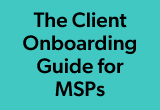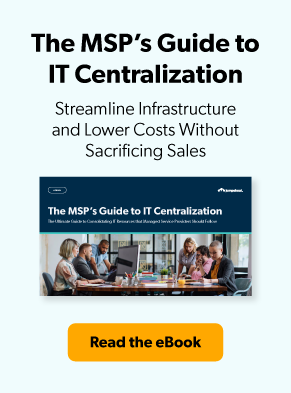This article is part three of a three-part blog series that expands upon our MSP’s Guide to IT Centralization eBook. Get your free copy today.
IT tool sprawl is an all-too-common issue for MSPs, particularly those who had to evolve their systems quickly to support clients through the pandemic. But in order to give your clients the most streamlined, efficient user experience possible, you need a top-of-the-line, all-in-one tech stack. IT centralization is the path to those efficiencies. Centralization has many benefits for MSPs and their clients, including cost savings, a streamlined user (and management) experience, and an increase in client trust.
That may make sense in practice, but the actual act of centralization can feel daunting. That’s why we put together this series to explain the three steps to IT centralization. So far, we’ve covered identification and incorporation. Now, let’s move on to the final step: consolidation.
What is Consolidation?
As the final step in the IT centralization process, consolidation is the point where you remove your irrelevant or unnecessary tech solutions and begin fully leaning on your newly chosen core platform. By this point, you’ve already chosen a core that fills in your current gaps, and you’ve connected that core to your IT tools as well as your external business tools like your HR and sales platforms. All that’s left is to remove the outdated platforms or applications your workforce should, at this point, no longer be using.
Consolidation is truly the purpose of the entire centralization effort, because it’s here when you get to remove the old platforms that you’ll see your greatest cost and efficiency savings. With a newly consolidated, streamlined core, your user experience should be simpler than ever, and you should be confident that the only tools left in your stack are those that your company truly needs in order to thrive.
Consolidation Best Practices
In many ways, consolidation is the simplest step of centralization, since it’s just the act of officially phasing out, or turning “off,” your outdated and now unused applications. But these best practices will ensure your final step runs as smoothly as possible.
Work Out the Kinks, Then Consolidate
Our previous centralization steps have shown the importance of phasing your old tech out slowly and deliberately, and consolidation is no different. It’s not enough to simply offer a better platform solution and take away the irrelevant versions. It’s much more prudent to keep the legacy applications in play until you’ve worked out all the kinks in your newer system.
Keeping the older applications throughout this process ensures that there is no downtime in productivity. In the event an issue arises that needs to be solved for before the new core can be fully functional, employees can still get their work done using the platforms they already have. This keeps frustrations low, and instills a more positive association with the new solutions.
After a few weeks of using the new platforms, your help desk tickets should reduce significantly – that’s how you know it’s safe to begin consolidation.
Make Sure Team and Clients Are Well-Informed First
Before you pull the trigger on consolidation, make sure your team – and your clients – have plenty of notice to prepare.
For clients, very little may change in their user experience, other than different looking push notifications and a few new log-in requests. Nevertheless, make sure you send out emails in advance letting them know what’s changing, how they need to respond to the changes, and why it’s good news for them. On the day when you’re decommissioning the legacy tech, make sure you have extra IT admins on hand to support and questions or concerns.
For your internal team, make sure they too are well-informed of the last day their old applications will be available, and make sure they’re all using the new core confidently and regularly before decommissioning the old one.
Have Extra IT Support On-Hand During the Transition
Finally, when it’s time to remove all the outdated, consolidated tech solutions, make sure your internal teams and your clients are well-supported with extra IT staff for troubleshooting, tutorials, and to answer any one-off questions. Hopefully, you’ve prepared your teams well in advance of these changes and no additional help is needed – but it never hurts to be extra prepared!
These beat practices should ensure a painless consolidation that becomes a positive experience for everyone affected.
Centralize Your Tech Stack with JumpCloud
Modern open directory platforms combine cloud directory services, privileged account management, directory extensions, web app single sign-on (SSO), and multi-factor authentication (MFA) into one streamlined solution. They offer centralized privileged identities instantly mapped to IT resources like devices, applications, and networks, regardless of platform, provider, location, or protocol. They also leverage multiple protocols such as LDAP, RADIUS, SAML, and SCIM so IT admins can seamlessly provision and deprovision, while users have secure, frictionless access to their resources.
If you’re interested in learning more about implementing JumpCloud as part of your IT consolidation strategy, download our Guide to IT Centralization to get all the details. Need to see someone else’s success with our platform firsthand? Check out our Combating IT Sprawl Webinar to learn how JumpCloud helped MiQ conquer IT sprawl in their environment.





